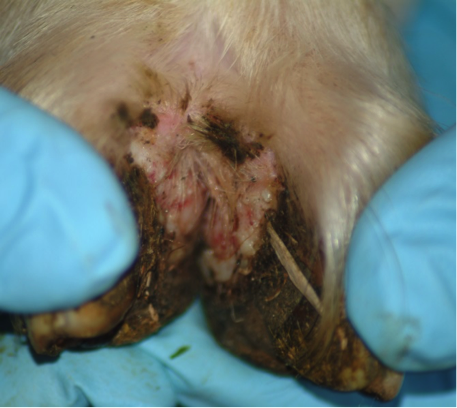What is foot scald?
Foot scald, or interdigital dermatitis, is an inflammation between the toes caused by the microorganism Fusobacterium necrophorum which is normally present in ruminant feces and is always present on grazed pastures. Foot scald affects both goats and sheep.
When does foot scald usually occur?
Foot scald occurs most often during persistent rainy weather or heavy dew such as spring with temperatures above 50°F. Persistent moisture on the skin softens the skin and damages the tissues between the toes, thus allowing the invasion by F. necrophorum. The combination of wet pastures with temperatures above 50°F allows the bacteria to persist away from the goats or sheep for longer periods of time. Trimming the long hair that covers the hoof may help the area dry out faster, and thus may help in the prevention of foot scald.
At the NC State Meat Goat Research and Educational Unit, cases of foot scald are mostly observed in spring while nursing does and their suckling kids are control-grazed on pastures. Young kids are very susceptible, but does will also be affected. Under wet conditions, cases of foot scald have also been observed in summer and fall.
What are the symptoms of foot scald?
The first signs of foot scald are limping and (or) holding limbs off the ground. Foot scald is characterized by inflammation of the skin between the toes. The skin appears pink to white in color, moist, raw, and very sensitive to the touch. In advanced cases, the affected areas may also have a characteristic bad odor. Affected animals need to be treated, because foot scald often can be followed by foot rot.
How to treat animals which have foot scald?
Individual cases of foot scald can be treated topically using solutions of copper sulfate or zinc sulfate (see products below) by squirting the solution between the affected toes. If the animals are on pasture, treating them after the dew is gone on clear days will allow the solution to dry on the hooves and feet, thus improving its effectiveness. During periods of persistent rainy weather, affected animals should be treated once or twice a day, depending on the severity of the case. Hooves heal rapidly after 1 or 2 days of twice a day treatment, but can recur easily if wet conditions persist.
What products are available to treat foot scald?
- 11.2% zinc sulfate solution already prepared
- squirt solution on affected areas
Liquid Zinc Sulfate (Premier FootCare) from Premier1
- Comes in quarts or gallons
- mix 1 part Premier FootCare with 3 parts water
- squirt solution on affected areas
15% copper sulfate crystals (CuSO4) from Tractor Supply
- 15 lb container (used to get rid of algae in ponds)
- 6 ounces (170 g) CuSO4 crystals + 1 quart of water
- let sit overnight for crystals to dissolve
- squirt solution on affected areas
- 6 ounces (170 g) CuSO4 crystals + 1 quart of water
CAUTION: Copper sulfate is not recommended for sheep due to toxicity issues because the treated animals may lick the sprayed areas following treatment.
Publication date: Oct. 8, 2015
Reviewed/Revised: Sept. 17, 2020
N.C. Cooperative Extension prohibits discrimination and harassment regardless of age, color, disability, family and marital status, gender identity, national origin, political beliefs, race, religion, sex (including pregnancy), sexual orientation and veteran status.

